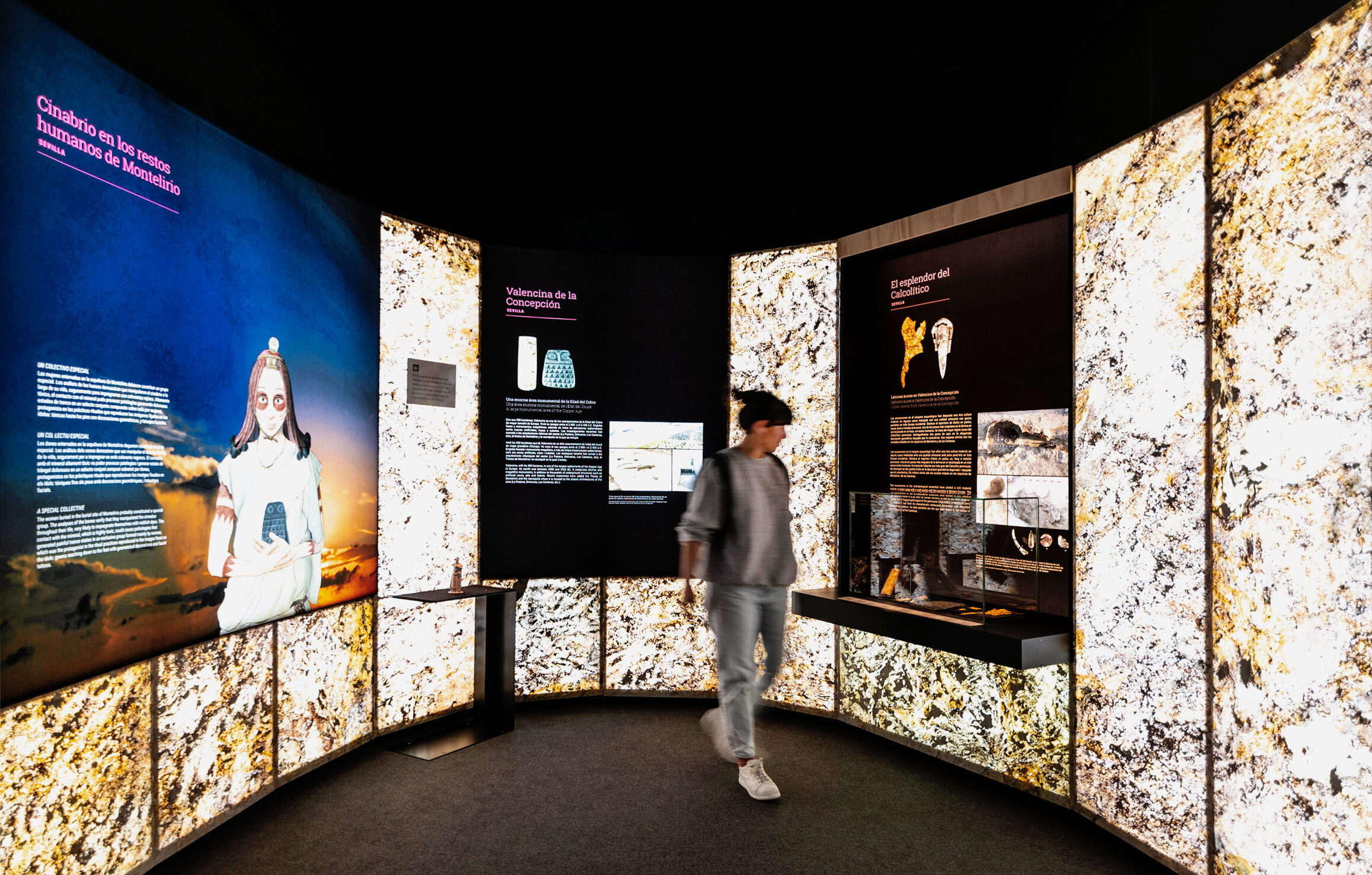IDOLS

MILLENARY GLANCES
Client: Provincial Archaeological Museum of Alicante Date: 2020 Categories: Archaeology, Itinerant Exhibition, Temporary Exhibition, International Exhibition, International Exhibition
1_Exhibition Provincial Archaeological Museum in Alicante (MARQ), Spain 2_ExhibitionRegional Archaeological Museum in Madrid (MAR), Spain
THE COMMUNICATIVE ARCHITECTURE OF THE IDOL EXHIBITION
From the access to corridor one, the visitor can put in context the object, the architecture of the object and the human scale, through a set of two sculptures with eyes painted in red, one of them elaborating an idol, and behind a context of scene place, a dolmen.
THE EXHIBITION IS DIVIDED INTO TWO ROOMS
The first one talks about typology, exposes the visitor to typological situations of the idol in relation to the user and his body, and other geographical situations, in relation to the Iberian Peninsula. The second room talks about the place and the possible use of the idol. It exposes the visitor to situations of use and place of discovery. The narrative museographic architecture speaks of the space of life, the space of death, the village, the burial, the daily life, the ritual.
In the first room, the exhibition space is resolved by means of Mediterranean cave architecture. Architectures through bases in the form of stalactites (light) and truncated stalagmites (bases), which speak of the appropriation of the place and natural architecture as the basis of the object. The way of displaying the idol on a base in the shape of a pyramid trunk, makes the idol is exposed as a single piece, meaning the whole (base and piece) as an altar. Room one is developed through 11 showcases with more than 35 pairs of stalactites and stalagmites, which support the objects as unique pieces of art. The inverted base (stalactite) that floats above each of the pieces, is the one that builds the intimate space of each of the pieces, bringing the point of light, placed in the lower base of the stalagmite and closes the set piece-base-point of light as an iconic, intimate and precious set. As a unique piece of art…
Accessibility and communication through other tools in room one are diverse, with special emphasis on a model of the peninsula with almost 50 idols that mark the geographical space to transmit to the visitor parameters such as density and place. Another line of reproductions offers the visitor a clear and concise understanding of the typological equalizer, touchable, and with Braille reading. These two didactic and accessibility facilities provide all visitors, whether a group of children or visually impaired people, with a parallel tool to the scientific discourse that complements it in a rigorous way and makes it permeable to all profiles of those who visit the exhibition.
Another audiovisual didactic tool that has been introduced in a novel way in this exhibition has been, in parallel to those already being used in narrative type audiovisuals, video pieces that give the visitor a sequence and succession of images that communicate in parallel to the archaeological piece details on a larger scale of the pieces, global scale of the detail, movement, typological comparison and three-dimensional comparison, in a comfortable, powerful and simple way. These videos provide the visitor with additional information beyond the contemplation of the archaeological object.
The second room builds the narrative space through curved enveloping walls that bring to the visitor the psychology of the architecture of the place where the idol is found. Four rooms, of different scales and with two different finishing materials, serve as museographic support for some twenty sites. These two finishes, natural wood and stone, serve as support for daily life in the village and the usual funerary enclosures. Natural wood and stone, architectural finishes, bring us two surfaces, the organic and the stony, they bring us life and death.
The first two spaces in room two provide the visitor with rigorous scientific information on each of the sites, in clear and clear sets. These first two rooms, the wall finish is natural wood, which brings to the visitor the experience of smell, the experience of touch, of the organic, of daily life, and of the village.
The second two spaces of the finished room are made of backlit natural stone. They bring to the visitor’s imagination the cutting of the orthostats that build the architecture of Montelirio. These two stony spaces bring to the visitor the texture of stone to the touch, the texture of the inert of the funerary ritual space and of death.
In relation to the accessibility elements in this room 2 is solved with a model of the Millares de Almería settlement, of large format of 1.50×1.10m. Through touch and contemplation, in the center of the room, it facilitates the understanding of the architecture of the village site and the daily life of every visitor.
The scientific context of the object is developed through small exhibition strips with showcases, images of the different sites, scientific texts, concatenated through the museographic envelope of the succession of short walls that make up the curved architectural space.
Location: MARQ (Alicante, Spain) Production: Antra Museum Design: Rocamora Diseño y Arquitectura Photographs: Rocamora Diseño y Arquitectura

